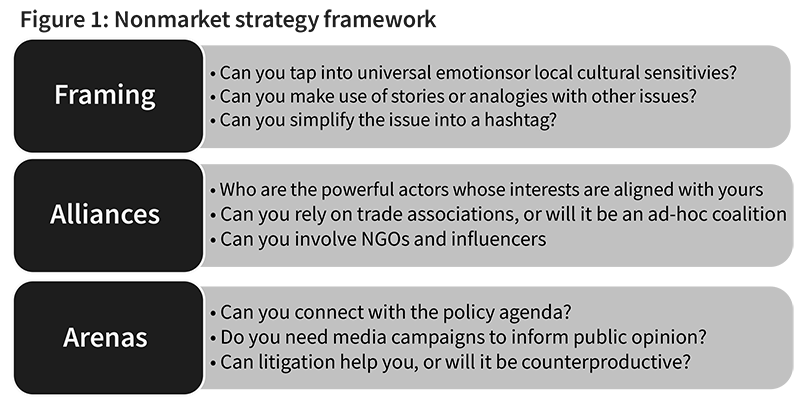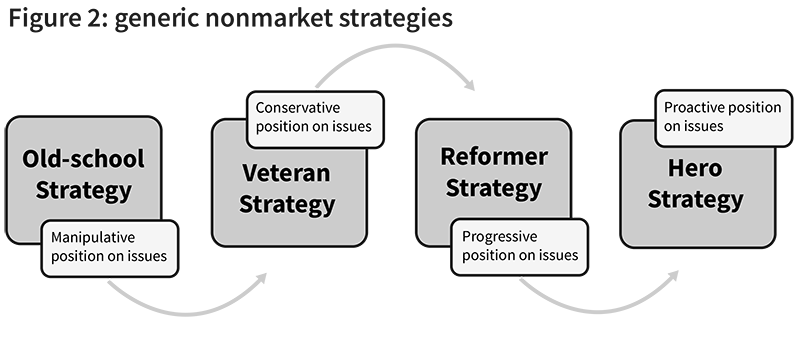Companies do not only compete in markets; they also compete on social and political issues. Depending on the business opportunities or threats they identify related to an issue, companies will behave as veterans that defend the status quo in an industry, as reformers that will work with the authorities to change the rules of the game, or as heroes that help solve an issue. In this article, we identify the typical elements of success for each of these three generic nonmarket strategies. We do this based on a framework that focuses on the framing of issues, the alliances that can be mobilized around an issue, and the arenas that can be used to make a move.
My take on strategy1
In 1979, Michael Porter2 observed that managers were too focused on their market positioning against direct rivals. He argued that rivalry within an industry is only one of five competitive forces. The other four are the bargaining power of buyers and suppliers and the threat from substitution and new entrants. Porter also illustrated how these competitive forces shape strategy. He argued that by analyzing their industry, managers will know better how to choose between two generic strategies: low-cost or differentiation strategies. This is still what we teach in business schools today and what is practiced by most companies. Many other contributions followed to help companies formulate differentiation strategies with concepts, such as customer intimacy,3 and blue oceans.4
In 1995, David Baron5 broadened the concept of strategy from market strategy towards integrated strategies with market and nonmarket components. Companies indeed do not only compete in markets; they also compete on social and political issues. Issues can mature from something that a few activists care about to mainstream concerns that can change societies and trigger government interventions. These interventions can impact companies directly, or indirectly via their suppliers, buyers, rivals, or substitutes. Interventions can be a threat as well as an opportunity; they can open or foreclose new markets; they can create a cost advantage or disadvantage; they can change the price setting in your industry; they can handicap or propel new entrants. Baron also introduced the I^4 framework6 with issues, interests, institutions, and information to help companies analyze their nonmarket environment in analogy with the Porter framework to analyze their industry or market environment.
In 2017, Sinziana Dorobantu, Assem Kaul, and Bennet Zelner7 proposed a nonmarket strategy topology from the perspective of institutions. They argued that firms operating in countries with captured or incomplete institutions, will need a different nonmarket strategy than those operating in a context with stronger institutions. Dorobantu et al. made an overview of different streams of relevant literature to conclude that firms can adapt to a given institutional setting, they can also transform institutions or establish their own institutional structures. They can decide to do this alone, or in collaboration with other actors.
To complement the institutional perspective, this article looks at nonmarket strategies from the perspective of social and political issues.8 Managing issues implies making choices on how to frame the issue, in which government and media arenas to make a move, and who to mobilize in an alliance. We provide guiding questions to formulate a nonmarket strategy in this three-dimensional framework with framing, alliances, and arenas. We also distinguish four generic nonmarket strategies: most choose to be conservative with veteran strategies, progressive with reformer strategies, or proactive on issues with hero strategies; unfortunately, some choose to manipulate issues with old school strategies. We finally identify the elements of success for hero, reformer, and veteran strategies.
Competing on issues and solutions to issues
For each issue, there are competing views. Issues have early adopters. If they care enough to convince others, they will become activists. Others will ignore or actively oppose the issue. Some issues reach a tipping point9 leading to mediatized public outrage. This will motivate government to act or it will motivate voters to elect new political representatives. Even before government intervenes in an industry, the pressure from activists or other interest groups can reach levels that force companies to change their position. For example, several big brands boycotted Facebook advertising for not doing enough against racism on their platform.
Paul Slovic10 has been a pioneer in identifying the factors that explain public outrage for issues, which he refers to as risks. Based on surveys, he showed that we do not only have scientific information about risks, but we also have feelings or perceptions. The factors that play a role include the novelty, severity, fairness, and context of the issue. For example, product safety is an issue in most industries, but issues with product safety are more likely to create outrage in a new industry or product line. If a self-driving car has an accident, it makes all the headlines, while other car accidents hardly get any attention anymore. Many years ago, this was the same for cars when they started to replace horses. When something is new, there is also limited scientific information available or it has not yet reached the public to help us build trust. The severity of an issue is more than the information that is available on how exposed we are to that issue. We perceive something to be more severe if the impact is catastrophic as opposed to chronic. Cars make more casualties on an annual basis than planes, but more people are afraid of flying than they are of driving a car. When the Boeing 737 Max crashed, it was an incident that created a lot of outrage because it was unfair. The company cut corners on safety to maintain market share. The risks were assigned to passengers and the benefits went to the company. The passengers were coerced into that risk; they had not chosen to be the test group for that new plane. A company testing a new vaccine to save lives with a test group of people that volunteered is a very different situation. Context also matters. Boeing made a good villain in some parts of the world as an American company with non-American casualties, all morally relevant to understand how the public and the authorities reacted to the issue.
For each issue, there are also competing solutions. Some issues are so close to government intervention that opposing the issue is useless. Issues are no different from Porter’s competitive forces. You can defend your position on issues, but at some point, you either embrace the change or risk becoming obsolete. The tech industry underestimated the public outrage against their practices and overestimated their abilities to influence legislation. The General Data Protection Regulation11 was ridiculed as red tape produced by the European Union, but it went ahead, and became an inspiration for similar legislation in other parts of the world. The Clean Energy Package12 had the political objective to create a new deal for energy consumers. Many doubted that this objective could be translated into meaningful legislation. New innovative industry players and citizen cooperatives seized the opportunity. They successfully argued that they are part of the solution and were influential in shaping that legislation. It helped to mainstream their business.
Nonmarket strategy formulation
Nonmarket strategies are about framing, alliances, and arenas. In what follows, we provide a few guiding questions that can help companies formulate a strategy in this three-dimensional framework.
Framing
There are many ways to talk about an issue. For example, the effect of greenhouse gas emissions on our planet is an issue that has been framed as climate change and as global warming. Focus groups13 showed that people are more concerned about global warming than about climate change. Experts might argue that climate change is more accurate than global warming. Climate models also project an increase in the variability of the weather partners with heatwaves and winter storms. Experts often try to be “correct”, but the feelings that non-experts have in response to their terminology will not always be neutral.
Framing14 is indeed about connecting with the feelings of the audience you are trying to persuade. Issues can be connected to universal emotions, or local cultural sensitivities. Framing can also be combined with stories and analogies to make the message stick.15 Complex social and political issues can even be framed with hashtags such as #MeToo and #BlackLivesMatter.
Immature issues are issues that have not yet been framed. Mature issues have established terminology that will be difficult to change. However, mature issues do not necessarily have mature solutions and framing is equally important for the competing solutions. Veterans and reformers will compete with narratives that try to convince government or their voters about their solutions. Solutions can also become highly technical discussions within a bubble of experts closely following a legislative file. Even among these experts, framing will take place.
If we agree on an issue and the best solution to that issue, framing is perceived positively as nudging behaviour in the right direction.16 Nudging has been used to make us smoke less, eat healthier and take better care of our retirement. If we disagree, framing can be perceived negatively as manipulation. The neutral perspective is that framing is one of the dimensions in which actors compete to advance their interests on an issue. This competition is stronger for issues that are immature; mature issues have established terminology and/or hashtags.
Guiding questions to use framing to communicate effectively:
- Can you tap into universal emotions or cultural sensitivities?
- Can you make use of stories or analogies with other issues to make the message stick?
- Can we simplify the issue into a hashtag?
Alliances
Big companies or trade associations are powerful because of their size. Too big to fail is a concept we know from the banking and financial services industry. Size is politically relevant in market value, employment, and tax revenues. Existing associations are also a source of power. Governments often prefer to listen to associations of companies with common positions. Establishing a new association is costly and takes more time than creating a new working group within an existing association. An established industry with more homogeneous companies, will typically be better represented via associations than a newer industry that is more heterogeneous.
Reputation can enable companies to play above their weight because trust is a source of power. Big companies are not always credible as reformers. Authorities increasingly listen to smaller companies to know how they can stimulate innovation by helping them to compete with the more established players. Trust is a combination of ethical standards and competence. An Edelman survey17 showed that companies are on average perceived as more competent than NGOs, but with lower ethical standards. This means that companies and NGOs are more trusted if they can form an alliance for some issues.
Influencers can also play a key role. Experts from consultancies, think tanks, and universities can produce studies with facts that inform the debate. They can moderate debates and educate on certain issues. This however requires a proactive approach. Independent experts need time to research an issue before stepping into a heated debate. Their biggest asset is their reputation, which they can lose if they are perceived as biased.
Guiding questions to mobilize powerful alliances:
- Who are the powerful actors whose interests are aligned with yours? Do they provide employment, pay a lot of taxes, or is it their contacts, or reputation that makes them powerful?
- Can you rely on trade associations, or will it be an ad-hoc coalition? Is it opportune to institutionalize the ad-hoc coalition into an issue-specific association?
- Can you involve NGOs and influencers?
Arenas
There are multiple levels of government from global to local. Governments consist of elected representatives and administrations that support them. They work with consultations, hearings, communications, impact assessments, drafts of legislations, procedures for amendments, and activities to monitor and enforce implementation. It is important to know where a certain file is being discussed and who are the key people to talk to at each stage of the process. Authorities can be sector specific or issue specific. Sector specific authorities include the banking, transport, water, and health care regulators with mandates to take technical decisions in these sectors. Examples of issue specific authorities include data protection and environment protection agencies, with mandates that cover most sectors.
Relationships and contacts are important to move information at the right time in the relevant arenas, but they will not get you very far if you do not have convincing arguments, backed up by credible evidence. The more technical the administration or agency is, the more the staff will listen to technical arguments as opposed to political arguments. Initiating discussion platforms on issues can help to push them higher on the agenda of governments and can also help to identify opportunities for nonmarket strategies on these issues. This is also the case for working groups initiated by government.
Media has the double role of entertainment and watchdog on issues. Reformer or veteran strategies might be covered by the watchdogs if they have a broad enough societal relevance. Old-school or hero strategies also have the potential to reach the popular media with stories of company villains or heroes. Public advocacy campaigns can target specific audiences. They can even target the bubble of experts that are close to the negotiation on a legislative file.
Nonmarket strategies can also involve litigation. Regulatory authorities are often challenged on the scope of their mandate or on the procedures they followed to come to a decision. Litigation can clarify the grey areas in legislation and can therefore also inspire new solutions to issues that have not yet been settled. Some regulators welcome court decisions to create legal certainty, others take it personal that their authority is being challenged. The role of litigation in handling issues is very much context specific.
Guiding questions to move into relevant arenas:
- What is the policy agenda and how can you connect with it to advance your interests on an issue?
- Do you need media campaigns to inform the public opinion? Who to inform and via which media channels can you reach them?
- Can litigation help you, or will it be counterproductive?
Generic nonmarket strategies
Companies can be manipulative, conservative, progressive, or proactive on issues. The manipulative position should not even be an option but is sometimes chosen anyway. In what follows, we discuss the corresponding nonmarket strategies.
The old-school strategy is to ignore, minimize or even misinform issues. The tobacco industry lied and deceived the public on the health effects of smoking. The car industry installed software to cheat emission standards for diesel cars. These unethical practices are increasingly investigated and exposed by other actors, such as activists, NGOs, and government agencies. These companies will have their reputation permanently damaged. Even if they try to clean up their act, other actors will be reluctant to be associated with them.
The veteran strategy is the default reaction from incumbents in an industry. It is to acknowledge the issue, but to challenge the solutions. For example, it recently came to light that fish sticks contain more fish in Western than in Eastern Europe. Same difference in quality standards applies to many other products. This caused public outrage in Eastern Europe and a reaction from European Institutions to introduce a ban on what was called dual food standards.18 The food industry responded by acknowledging that they are against deliberate dual food standards, but a ban would also limit the customization of products in response to local tastes, local ingredients, and regulatory requirements. Another EU legislative initiative to tax the revenue of digital businesses was challenged by the European industry.19 They argued that it would hurt them more than global tech firms. Industry on these occasions successfully delayed legislation by identifying politically relevant unintended consequences. The issues did not disappear so it is possible that new solutions will be put on the table in the future. They will continue to be challenged by veterans, but reformers could also emerge that help the authorities to come up with more successful proposals.
A reformer strategy means that the company acknowledges the issue and works with the relevant authorities to find solutions that then change the rules of the game for the whole industry. This is a strategy that can be followed by new entrants and incumbents. Many new entrants operate in a regulatory grey area in conflict with the incumbents and possibly also with the authorities. This is the case for digital platforms like Uber and Airbnb who refuse to be licensed as a taxi or hotel business. This was also the case for several innovative energy players in the EU until the Clean Energy Package shed some light on these grey areas in favour of the new entrants. Incumbents typically start by opposing new rules in their industry until one of them sees the opportunity to become a reformer. By working with the authorities, the first mover can influence the legislation that rivals are opposing. Proactively applying new rules can also enable learning and provide a cost advantage over rivals when they are forced to follow. Examples include the companies that have been first movers on environmental issues.20
A hero strategy means that the company acknowledges the issue and proactively contributes to solving it. Most companies have some activities that are labelled as corporate social responsibility or sustainability. If these activities are chosen strategically to help when it is most needed, using the unique hero skills of the company, it can be very impactful. During COVID-19, luxury brands produced mouth masks to help address shortages. Decathlon’s diving masks were turned into respiratory devices for hospitals. Following a request from a doctor in Italy, a 3D-printing start-up designed the interface between the hospital tubes and the mask. Decathlon took the remaining masks off their shelves and made them available to hospitals. Walmart21 is another company that was applauded for their hero skills when everybody was watching. When Hurricane Katrina hit New Orleans, the authorities failed to reach the area’s most affected by floods. Walmart had anticipated what people needed the most and they had the logistic capabilities to reach them.
Successful nonmarket strategies
Veterans can typically rely on well-established industry associations, but they have the challenge to effectively communicate about unintended consequences. The nonmarket position of veterans is often weaker than they expect based on their market position and expertise. They also risk becoming frustrated because company experts are not always understood or trusted. Experts tend to lose the sensitivities that others will have when confronted with an issue, which has been referred to as the expert trap.22 NGOs and influencers might also be reluctant to collaborate with veterans. Empathy is a key ingredient of every successful nonmarket strategy, especially for veterans.
Reformers often underestimate their opportunities in media and government arenas. They need to be more present in these arenas. They are part of the solution so framing is easier, but they have the challenge to create ad-hoc coalitions. Successful ad-hoc coalitions typically organize themselves more permanently into issue-specific associations. These alliances can bring together NGOs, first-moving incumbents, and new entrants. Buyers or suppliers might also join such a coalition if they see new opportunities in an industry that is shaken up by reform. Smart Energy Europe is an example of an issue specific association of new energy players, first-mover incumbents, and suppliers that worked with the EU authorities on the Clean Energy Package. Fire Safe Europe is an innovative coalition of firefighters, fire experts, and suppliers of firesafe materials to campaign for how the #EUCanBeFireSafe.
Heroes need to be authentic. Every company can donate money for a good cause, but only Walmart had the logistic capacity to help after Hurricane Katrina hit New Orleans; only Decathlon had widely available and relatively cheap masks that could be retrofitted into respiratory devices during the COVID-19 crisis. If what you do is extraordinary and timely, it becomes an interesting story. You will be positively framed by others for helping to relieve a disaster. You will get more positive media coverage than you can get out of any other strategy or marketing campaign. However, doing something that is ordinary during a crisis, has a higher risk of being perceived as opportunistic, especially for companies that do not have a good reputation. To be able to act as a hero, companies need to be more aware of their unique hero skills. Heroes often go solo rather than forming an alliance.
Conclusion
In this article, we discussed why and how social and political issues shape strategy.
Why? Issues can mature from something that a few activists care about to mainstream concerns that can change societies and trigger government interventions. Issues that do not affect companies directly, can do so indirectly because they impact the suppliers, buyers, rivals, or substitutes in an industry. To remain successful, companies therefore need to be engaged on many different issues.
How? Nonmarket strategies are always about framing, alliances, and arenas. However, depending on the business opportunities or threats companies identify related to an issue, they will behave as veterans, reformers, or heroes. Being successful in these generic nonmarket strategies entails a few typical choices for framing, alliances, and arenas. Framing for reformers will focus on the solutions they provide to the issue, while veterans will highlight the unintended consequences of these solutions. Heroes do not have to frame; they will be framed positively by others for their efforts to relieve disasters. Alliances for veterans typically start from existing industry associations, while reformers more often resort to issue-specific associations. Heroes often go solo rather than forming an alliance. The main arenas from media to courts and government are equally important for heroes, reformers, and veterans. Being successful in these arenas is about authenticity for heroes, presence for reformers, and empathy for veterans.
About the Author
Leonardo Meeus is Professor of Strategy and Corporate Affairs at Vlerick Business School. He is passionate about the relations between companies, stakeholders and government. He helps organisations to take a broader perspective on strategy. Leonardo is also professor at the European University Institute where he contributes to the activities of the Florence School of Regulation. He works as an expert for European institutions, regulatory agencies, and companies via research contracts and advisory roles.
References
- 1 Thankfully acknowledge feedback by Carine Peeters and Martin Roach.
- 2 Porter, M. E., 1979. How competitive forces shape strategy. Harvard Business Review, 57(2), 137-145.
- 3 Treacy, M., Wiersema, F., 1993. Customer intimacy and other value disciplines. Harvard business review. 71(1), 84–93.
- 4 Kim, W. C., Mauborgne, R., 2005. Blue ocean strategy: how to create uncontested market space and make the competition irrelevant. Harvard Business School Press.
- 5 Baron, D., 1995. Integrated strategy: market and nonmarket components. California Management Review, 37(2), 47–65. Baron, D., 1995. The nonmarket strategy system. MIT Sloan Management Review, 37(1), 73-85. Baron, D., 2013. Business and its environment. (7th edition). New Jersey: Pearson.
- 10 Paul Slovic and colleagues found that depending on who they surveyed on what type of issues, the results could differ, but there are some factors that keep on coming back in all studies. Slovic, P., 2010. The feeling of risk: New perspectives on risk perception. Routledge. Slovic, P., 2016. The perception of risk. Routledge.
- 11 An article in the Economist discussed how GDPR inspired a law proposed in California. The article appeared in
- December 2019 under the headline “California’s data sheriffs”.
- 12 Meeus, L., 2020. The evolution of electricity markets in Europe. London: Edward Elgar.
- 13 An article in the Guardian referred to a leaked memo by the political strategist Frank Luntz advised the Republicans in the US to talk about climate change instead of global warming. By conducting focus groups, Luntz
- found that global warming had a catastrophic connotation, while climate change was perceived as something more controllable. The article by Oliver Burkeman appeared in March 2003 under the headline “Memo exposes Bush’s new green strategy”.
- 14 Bach, D., Blake, D. J., 2016. Frame or get framed: the critical role of issue framing in nonmarket management. California Management Review, 58(3), 66-87.
- 15 Making the message stick is a concept from the book by the brothers Heath. Heath, C., & Heath, D., 2007. Made to Stick: Why Some Ideas Survive and Others Die. Random House Inc.
- 16 Thaler, R. H., Sunstein, C. R., 2008. Nudge: improving decisions about health, wealth, and happiness. New York: Penguin Books.
- 17 2020 Edelman Trust Barometer, https://www.edelman.com/trustbarometer
- 18 An article in Euractive discusses the issue. The article appeared in April 2018 under the headline “EU bans dual quality food after pressure from eastern members”
- 19 An article in Financial Times described this opposition from European industry. The article appeared in November 2018 under the headline “The global hunt to tax Big Tech”.
- 20 Renato Orsato, 2006. Competitive environmental strategies: when does it pay to be green? California Management Review, 48(2), 127-143.
- 21 Daniel Diermeier discussed the Walmart case in his book. Diermeier, D. (2011). Reputation Rules: Strategies for Building Your Company’s Most Valuable Asset (1st Edition). McGraw Hill.
- 22 Daniel Diermeier discussed the expert trap in his book. See previous endnote for reference.









































